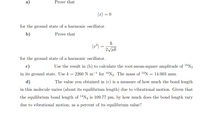Question

Transcribed Image Text:Prove that
(x) = 0
for the ground state of a harmonic oscillator.
b)
Prove that
(2²)
2 uk
for the ground state of a harmonic oscillator.
c)
Use the result in (b) to calculate the root-mean-square amplitude of 1ªN2
in its ground state. Use k = 2260 N m-1 for 14N2. The mass of 14N
= 14.003 amu.
d)
The value you obtained in (c) is a measure of how much the bond length
in this molecule varies (about its equilibrium length) due to vibrational motion. Given that
the equilibrium bond length of 14N2 is 109.77 pm, by how much does the bond length vary
due to vibrational motion, as a percent of its equilibrium value?
Expert Solution
This question has been solved!
Explore an expertly crafted, step-by-step solution for a thorough understanding of key concepts.
This is a popular solution
Trending nowThis is a popular solution!
Step by stepSolved in 3 steps

Knowledge Booster
Similar questions
- A particle has a wave function y(r)= Ne¯u , where N and a are real and positive constants. a) Determine the normalization value N. b) Find the average value of y c) Obtain the dispersion (Ar)? Note, you can use dz =r'(n+1) = n!arrow_forwardProblem 9: Rutherford Scattering A gold foil (5.9×1022 atoms/cm³) of "hair" thickness 80 µm is used in a Rutherford experiment to scatter a particles with energy 5 MeV. Find the fraction of particles scattered at angles 0 > 30°.arrow_forwardThe wavelength of the emitted photon from the hydrogen molecule H2 is 2.30 μm (micrometers) when the vibrational quantum number decreases by one. What is the effective "spring constant" for the H2 molecule in N/m ?What is the "zero point" energy (in eV) of the molecular vibration?arrow_forward
- Hydrogen gas can be placed inside a strong magnetic field B=12T. The energy of 1s electron in hydrogen atom is 13.6 eV ( 1eV= 1.6*10 J ). a) What is a wavelength of radiation corresponding to a transition between 2p and 1s levels when magnetic field is zero? b) What is a magnetic moment of the atom with its electron initially in s state and in p state? c) What is the wavelength change for the transition from p- to s- if magnetic field is turned on?arrow_forward24. Consider a modified box potential with V(x) = V₁x, Vi(ar), x a Use the orthogonal trial function = c₁f₁+c₂f₂ with f₁ = √√sin (H) and f2 = √√ √√sin sin (2) to determine the upper bound to ground state energy.arrow_forward
arrow_back_ios
arrow_forward_ios